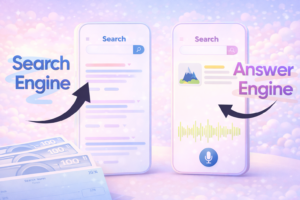Creating a mobile application presupposes being creative and coding competently and requires wise budgeting.
As a startup founder or a product manager at a big company, knowing how to estimate the cost of developing an app is important to select the right option to allocate a budget or develop a new app that will decide whether your digital project will make it.
It is not only a matter of quoting a number; it is about outlining the scope, setting the list of mandatory features, choosing the tech stack, and finding the right company to cooperate with a mobile app development company.
Decisions such as platform selection to use, e.g,. Native mobile application development vs. cross-platform tools, such as React Native mobile app development services, can have extreme ramifications in terms of cost and time.
Also, deciding whether to hire a freelancing or a dedicated mobile app development company, invest in a custom mobile application development, or otherwise becomes a part of the equation.
Here in this guide, we will simplify the step-by-step procedure to estimate your app development cost without any confusion or gap in knowledge, so that you can plan smartly, prevent budget creep, and realize ROI in your custom app solutions.
What Influences App Development Costs

Estimating the correct budget implies being aware of the determinants of the cost of app development.
When you would like mobile application developers to develop your mobile app or even when you would like to hire mobile app developers, the following are issues that will determine the end cost:
Project Scope & Features

The most important cost drivers are your app’s size and complexity.
Unexpectedly large screens, multi-step user views, options like login, data insertion, and user portfolios are quite superior in a rather inexpensive way.
Nevertheless, more complex features such as in-app purchases, real-time messages, video streaming, offline availability, or geolocation require additional time and specialisation.
Special logic and special user interactions will never reduce the schedule and budget.
Platform Choice
The selection of an adequate development platform carries significant budget implications.
Native mobile app development provides the best performance and access to platform capabilities, but in most cases, two codebases will be needed.

This enhances the development and maintenance work. In comparison, React Native mobile app development services enable code to run on multiple platforms and provide near-native performance at lower prices; therefore, budget-focused and time-bound projects are best suited to use React Native mobile app development services.
Design & User Experience
The engagement is essential and can only be achieved with a sleek and intuitive design, which is costly.
Off-the-shelf design templates are usually cheaper but do not match your brand identity.
Custom UI/UX design takes the brand’s user experience level and credibility to the next level, encompassing wireframes, prototyping, usability, and responsiveness to allow cross-device functionality.
Custom app solutions are a good investment because the end product will be professional and polished, which is crucial for high user retention.
Integration & Backend Infrastructure
Apps hardly exist in vacuity. Integrating your app to third-party services such as payment gateways, CRM, or enterprise APIs adds complexity to your backend: the database structure, backend code, and secure data transmission.
Cooperation with custom mobile application development services reduces failures and downtime and makes it possible to coordinate the work of frontend and backend teams during the project implementation.
Security and Compliance
Data security safeguards impose additional cost, GDPR compliance bottom line, and app store requirements.
This is particularly important in the case of regulated industries, such as healthcare or finance.
Developers must deploy encryption, safe authentication, and data management within legal and commercial guidelines.
It is not generally considered when starting, but it could have serious implications for the budgets when discovered later.
Ongoing Maintenance and Updates
The released app will require regular updates, bug fixing, and additional features.
Planning the cost of post-deployment is necessary, particularly when you have dedicated mobile app developers full-time to carry out improvements.
Maintenance normally takes up 15-20 percent of the initial development cost annually.
Team Location and Experience
The hourly rate of developers is highly regional.
Hiring developers in Western Europe or North America will be more expensive than hiring offshore teams in Asia or Eastern Europe.

However, experience and specialization can also be added to the equation.
Special teams with a proven record in custom mobile application development services may be more expensive, but they can frequently save time-to-market and provide a better quality.
2. Step 1 – Define Your App’s Purpose and Core Features
Your app before proceeding to the costs. What does it solve in business?
Did it exist to serve as an outward-facing consumer-oriented digital storefront, an internally-facing employee tool that enhances productivity, as a customer-loyalty program, or something that end-to-end service management is accessible to?
Paying attention to this gets your development path on the right track.
Then, I will determine what core features must satisfy that purpose. For example:
- User authentication (login/sign-up with a social account or with email)
- Payments in application (PayPal, Stripe, and Apple Pay integration)
- Updates and promotion push notifications
- GPS tracking (delivery or check-in location services)
- User profile management
- Content management systems (CMS) for admins to update app data.
Create a feature list and rank them by priority using a simple format like this:
| Feature | Priority |
| User login | High |
| Push notifications | Medium |
| Social media sharing | Low |
| In-app purchase support | High |
| Multi-language support | Medium |
The exercise will aid in isolating MVP (Minimum Viable Product) features and ones that the team can implement later in future versions.
Even when developing an application with a mobile app development company, being transparent with your MVP will make them recommend solutions suited to your organization’s budget when using custom mobile application development services.
Also, consider users’ roles (e.g., admin, end-user, vendor), scaling requirements, and third-party API connections.
When you hire mobile app developers, it would be best to provide them with a clear map in advance, so that there is less possibility of delays, and backtracking would be possible.
Finally, whether you focus on performance and UX, ask yourself whether you should choose native mobile app development instead of cross-platform approaches, such as React Native mobile app development services, because it is another factor that will affect your budget and schedule.
3. Step 2 – Choose the Right Development Approach
After you clarify your objectives with the app, now is the time to determine how you will bring your idea to life.
Will you hire mobile app developers on staff, work with freelancers, or have a mobile app development company? The two avenues come with their advantages and costs.
Hiring Internally

Creating an in-house team offers more control, effective communication, and ensures long-term business goals.
Your developers get to know your systems, users, and workflows intimately.
Nevertheless, hiring quality talent is time-consuming, and employing full-time programmers involves long-term salaries, training, and overhead expenses.
It best fits into the case of companies with stable development demands willing to invest in their internal tech departments.
Working with Freelancers

Freelancers are very cheap and are flexible when it comes to short-term or not too complicated projects. They are a common pick when it comes to MVPs and pilot apps, as there are many AI MVP tools that make the development process easier and faster.
There are, however, difficulties of control over several freelancers, accountability, and consistent quality.
You are also deprived of a collaborative atmosphere and the orderly procedure of a team setting.
Co-branding with an Agency
With a professional mobile app development company, there is an opportunity for a full-cycle design, QA, deployment, and support development.
According to the product objectives, many custom mobile application development services would create apps in your niche.
When your project is larger, you can also scale efficiently using dedicated mobile app developers.
The benefit of the option is that you will be handling the project with experienced professionals who have provided similar solutions before and can offer you strategic advice.
Agencies are also kept in touch with the most modern trends of the time, such as React Native mobile app development services that enable you to develop your cross-platform applications with speed and efficiency, and at a lower cost without letting the performance suffer.
Finally, select a model of development that suits your budgetary constraints, schedule, and internal capacities. Consider the trade-offs carefully since you have to choose a plan that will suit your idea in execution.
4. Step 3 – Select the Right Tech Stack
Choose between native or cross-platform development:
- Top performance and complete integration into the platform, native iOS (Swift) and Android (Kotlin).
- Needs its codebases, which doubles the degree of development and boosts its cost.
Use React Native mobile app development services:
- Allows a single code base between iOS and Android.
- Provides more like native performance at a cheaper expense.
- Accelerates time-to-market, perfect for start-ups and retail applications.
Decide on backend architecture:
- Serverless architecture is scalable, and it decreases maintenance.
- Microservices or traditional APIs best suit complex applications.
- Back-end decisions directly impact the infrastructure, web hosting, and support expenses.
Incorporate third-party services and tools:
- There is also a recurrent cost of using payment processors (e.g., Stripe), notification services (e.g., Firebase), and analytics tools.
- App Store (Apple/Google) charges should be considered when long-term budgeting.
Ensure scalability and security:
- When deciding to employ a partner to provide custom mobile application development services, one should ensure that the stack would facilitate growth and compliance (e.g., GDPR).
- User authentication frameworks and security provisions should be thought of in advance.
Hire mobile app developers who understand your domain:
- Whether you are developing a retail solution or a B-to-C platform, dedicated mobile app developers will help tune your stack in terms of performance and cost.
5. Step 4 – Estimate Time & Team Requirements
Here’s a typical team structure used for app projects:
| Role | Time Allocation (%) |
| Project Manager | 10% |
| UI/UX Designer | 15% |
| Frontend Developer | 25% |
| Backend Developer | 25% |
| QA/Test Engineer | 15% |
| DevOps/Support | 10% |
This is a six-month project, with two mobile app developers, two dedicated mobile app developers, one designer, a QA engineer, and a PM at a cost of around $120K- $200K, depending on location and rates. Agencies and freelancers may vary these percentages.
This decision has a few advantages since by hiring a mobile app development company, you can access preformed teams and a more reliable development plan.
6. Step 5 – Understand Design & UX Cost Factors

Design is one of mobile app development’s most essential but misjudged elements. It is much more than selecting colours or fonts, that is how people will use the application, and whether they will return.
Easy and natural user experience is a remarkable user retention and satisfaction measure. Designing apps usually involves:
- User journey maps, wireframes, and the creation of structure
- Established guidelines of branding and visual appearances, visual mock-ups, and icons
- Micro-interactions and animations to move users and provide better response feedback
- Cross-platform compatibility so that functionality and look can be identical in iOS and Android devices
- The accessibility design, where a user with varying capabilities must be able to use your app
Also, a bespoke, branded experience adds to the design.
When creating apps facing direct consumers, particularly in a competitive market such as retail or food delivery, it requires a touch of visual polish, including buttery transitions, and should touch the heart.
They can influence the design changes, A/B test changes to layouts, and follow specific guidelines to meet the user interface of a particular OS (such as Apple Human Interface Guidelines or Google Material Design).

Estimated UI/UX design deliverables, source
Collaboration with a custom app solutions provider guarantees that your app will be characterized by a powerful visual perception and people-focused mentality, reinforcing the engagement and brand credibility.
Given that your project needs custom mobile app development services, it is prudent that you have the UX specialists involved early enough during planning.
This assists you in avoiding expensive rework in the future and helps you ensure that every decision relating to the design aligns with your business objectives and the user’s expectations.
7. Step 6 – Include Post-Launch Expenses
Costs of applications are not limited to the release:
- Maintenance & Updates: 15-20% obligatory growth every year
- Bug fixes & support: by case per month
- Cloud hosting and tracking: related cost was spent on AWS, GCP, or Azure
- Registration fees for the app store and marketing costs
The logic of collaboration with the mobile app development company implies systematic assistance, optimization of performance, and keeping it safe with OS releases.
8. Sample Cost Breakdown by App Type
Here’s a simplified cost example for different app complexities:
| App Type | Estimate | Tech Stack |
| Internal Tool (MVP) | $50K – $70K | React Native |
| Consumer eCommerce App | $150K – $220K | Native |
| On-Demand Service App | $200K – $300K | React Native |
Developing apps using React Native with mobile app development services offered by an agency can save at least 30 percent of cost, compared to native builds, and still have wide functionality and performance.
Conclusion
Estimating the price of mobile app development is not a matter of guesswork but an effective approach that includes scoping, the choice of a tech stack, the selection of the development team, and support.
The optimal development partner is key to building an indigenous grocery delivery or organizing internal retail trading.
By partnering with an experienced mobile app development company, you can enjoy the expertise of mobile app developers, user-oriented design, and a Pricing model.
Software development teams that provide custom mobile application development services or React Native mobile app development services can streamline their delivery to a large extent with reduced long-term costs.
Following this step-by-step process, you will receive a clear project budget and establish the baseline of successful delivery and post-launch growth.
Are you ready to transform your app concept into a secure, scalable, and cost-effective solution?
To hire mobile app developers with proven experience implementing custom app solutions in retail, logistics, e-learning, etc. Contact us to receive a customized quote depending on your business objectives.
FAQs
1. How much does it cost to develop a mobile application?
Features, platforms, and team location can make the app development costs between $50K and $300K.
2. Are React Native apps more cost-efficient than a native app?
The answer is yes, React Native can lower the development efforts by 30-40% because of the duplication of iOS and Android codes.
3. How can I lower the app development cost without compromising the quality?
Employ the MVP scoping, prioritize what is required, and collaborate with a mobile app development company that provides custom solutions.
4. How much after-launch expenditure can I anticipate?
You should budget 15-20% of the build cost per year to maintain, plus cloud hosting and other costs to ensure regular updates and staff support.
5. Should I pay particular attention to freelance or have a special team?
Exclusive mobile app developers of a professional agency will ensure continuity, consistency, and quick delivery of the project.









